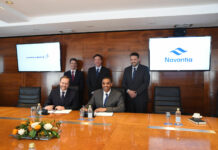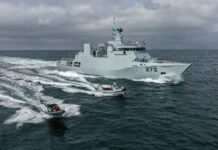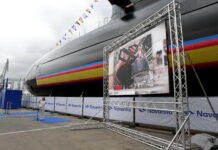A small group of submarine manufacturers took centre stage during the NIDV exhibition in Ahoy, Rotterdam, the Netherlands. Rebranded into NIDV Exhibition Defence & Security (NEDS), the event held on 28 October 2019 attracted potential subcontractors including integrators, engineering companies and suppliers of components and naval mission systems.
Among the companies present were RH Marine, Thales Nederland, Van Halteren Defence, Bosch Rexroth, Solico, and Verebus Engineering. Organised into the NIDV’s Dutch Underwater Knowledge Centre (DUKC), they were located around the booths of Damen-Saab, Naval Group, Thyssen Krupp Marine Systems (TKMS) and Navantia. And they had good cause to be so.
Navy Requirements
In order for the Royal Netherlands Navy (RNLN) to “provide almost all of the maritime forces requested by NATO”, the alliance’s latest Defence Planning Capability Review (DPCR 2018) considers “the replacement of the M class frigates, the mine countermeasures vessels, and the WALRUS class submarines a pressing issue as current capabilities are becoming obsolescent”.
It is known that the aim of the Dutch government is to let Damen Schelde Naval Shipbuilding (DSNS) build two new frigates for its navy citing essential security interests under Article 346 of the Treaty on the Functioning of the European Union (TFEU). This is similar to the way that the Netherlands are dealing with their more pressing requirement for a new Combat Support Ship with a formal contract soon to be awarded to Damen.
Meanwhile, the MCM proposal of the Naval Group/ECA Group consortium was recently selected to provide Belgium and the Netherlands with a next generation mine hunting capability.
This leaves the replacement of the navy’s current SSK capability which is now planned to commence in 2028.
Involving a budget of some €3.5Bn, the project’s RFI or so-called A-letter was issued in accordance with the MoD’s Defence Materiel Process (DMP) in June 2016. According to initial planning, the outcome of the information phase was to be made public by mid-2018. However, the publication of a national Defence Industry Strategy which eventually occurred in November 2018 led to some delay. With the WALRUS SSK replacement programme currently being the MoD’s largest and most important procurement programme that is still in the bidding process, the Dutch government wants to make sure that potential suppliers take into account as much involvement of local Dutch industry as possible. Hence, during NEDS 2019, the international submarine industry was eagerly awaiting the project’s next milestone or B-letter. Published on 13 December, it saw only Navantia being eliminated with the remaining three contenders being shortlisted pending a formal selection that is now expected to be finalised in 2022.
More compelling demands on the Netherlands, not just by NATO which is confronted with a shortfall in ASW capabilities, but also politically by the EU have made the Netherlands look for synergies, during the development, building, and subsequent sustainment of submarines. This is the reason that the Netherlands joined the Conventional Submarine Cooperation (CSC) scheme which is aimed at streamlining submarine R&D, technology, training, operations, as well as in-service-support (ISS). Created in 2014 by Germany, CSC has also been joined by Italy, Norway, Poland and Portugal, all of them current users of TKMS sub technology except for the Netherlands.
In addition, the Dutch MoD has been monitoring developments concerning SSK procurement in partner countries such as Australia, Canada, Germany, Norway, and Sweden, the latter of which, unlike the other four countries mentioned, does not participate in the Netherlands Submarine Command Course (NLSMCC).
Initially a series of options for the replacement of the WALRUS class were considered by the Dutch MoD. They included a mere homeland security (or coastal defence) variant, going fully unmanned, or even the zero-option with systems other than submarines to be employed.
However, the Netherlands navy is now fully focused on acquiring another oceangoing SSK, albeit one that might be less future proof than hoped for, con-sidering it being called “a B-variant”. While the Dutch remain committed to fielding four submarines of a MOTS design tailored to national needs, the current cap on funding will lead to a somewhat smaller submarine that likely has a less than optimal weapons and mission payload. With a premium on stealth, the desired follow-on submarine capability should anyhow be able to operate in shallow coastal waters in support of SOF or for intelligence gathering purposes, a requirement which was at the basis of the current Walrus class X rudder stern configuration. However, the navy’s self-deployment requirement meant to enable out of area/expeditionary operations complicates possible cooperation with other countries as it leads to a relatively large SSK.
Ideally, the new 3,000 tonnes vessels are to be equipped with ASW/ASuW, provisions for land attack missiles, AIP, and off-board sensors such as UUVs and ROVs with non-penetrating masts being the norm for optronics. Having accommodation for both male and female personnel, the new subs will also require a high degree of automation in order to enable so-called “lean manning”.
Industrial Solutions – Damen-Saab
Speaking to ESD during NEDS 2019, Robin Middel, working on behalf of Damen-Saab through Havana Blue Maritime PR, is convinced “80% of submarine building knowledge is still present in the Netherlands”. To cover the remaining 20%, Damen has opted for a partnership with Saab from Sweden, which Middel emphasised “is an equal partner country with a similar culture unlike larger European countries such as France and Germany”.
Featuring signature optimisation and a multimission portal for launching and recovering UUVs and other payloads, the modular Kockums A26 is at the basis of the Damen-Saab proposal to the Netherlands. Depending on hull diameter and length, the A26 family allows for a displacement potential in excess of 3,000 tonnes, hereby enabling an Oceanic Extended Range version that appears aimed at the Dutch requirement. For AIP, it features the Stirling system which burns a mixture of gasified pure industrial liquid oxygen and diesel fuel.
If chosen, Saab will build the submarine’s hull parts in Karlskrona, Sweden. Assembly will then be conducted in Vlissingen, the Netherlands with maintenance to be conducted in Den Helder. Middel was adamant about the export potential of Saab-Damen’s proposal, saying it would benefit both Swedish and Dutch industry, the latter by producing the required mission systems.
TKMS
Any submarine deal will see “a trade-off between capabilities aimed at meeting requirements, cost, both for procurement as well as life cycle costs, risk, and local workshare”, one of TKMS’ representatives present in Rotterdam told ESD (name withheld on request). Asked about risk, he emphasised the relevance of the company’s “substantial track record” in developing and building conventional submarines. “We work with an actual production line work force. That is what makes us stand out”.
TKMS is proposing a derivative of the company’s 2,400 tonnes HDW Class 212CD submarine that was recently selected by Norway and Germany: “We have the ability to tailor it in order to meet Dutch requirements. The architecture of the KTA (Kongsberg, TKMS, ATLAS ELEKTRONIK) CMS for instance allows for integration of Dutch designed software”. Vertical launch tubes are also on offer together with the company’s Interactive Defence and Attack System for Submarines (IDAS).
“Specialised in automation”, TKMS also touts its mature AIP fuel cell technology which is unlike that of other companies that are “still working on it”, the representative boasted.
“Designed for maximum stealth”, the TKMS proposal offers “a unique a-magnetic steel pressure hull”. According to the company, this also helps to reduce costs of maintenance with TKMS claiming LCC typically encompass 70% to 75% of overall costs. If selected, TKMS will build the submarines in Den Helder, the Netherlands, which when linked to Kiel, Germany would create a so-called “Submarine Valley”.
IP Transfer – Naval Group-Royal IHC
During NEDS 2019, ESD was also welcomed by Naval Group’s Eric Chaplet. A former admiral and SSN, SSBN submarine captain of the French navy, Chaplet now leads the marketing department of Naval Group which has aligned with Royal IHC for the Dutch bid. The latter company is particularly well known for its experience in designing and manufacturing dredging vessels. Technically complicated as they are, experience in this field will contribute to a low risk approach for the consortium’s WALRUS replacement offer, it is believed. Dredging vessels require “massive amounts of software code in order to operate, far in excess of the amount used to run a typical frigate for instance” according to Louwrens op de Beek, Royal IHC’s commercial director defence.
Chaplet indicated the group’s current offer is based on the 4,500 tonnes SHORTFIN BARRACUDA oceanic diesel-electric design that was successful in Australia for SEA1000: “Like in Australia, we intend to build as much in the Netherlands as possible”. If selected, Royal IHC will build the submarine’s modules with final assembly also to take place in the Netherlands. Although most design work would initially be done in Cherbourg, this capability would “shift over time to the Netherlands”, Chaplet said. Naval Group and Royal IHC have already agreed on sending Dutch personnel to France starting from 2020 in order to learn relevant skills.
Naval Group prides itself in being a leader in the transfer of intellectual property, this due “to recent deals in Brazil, India and Australia”. Chaplet said: “Transfer of knowledge is guaranteed starting from the beginning, hereby allowing full autonomy”.
Like his counterpart from TKMS, Chaplet emphasised the importance of a continuous track record: “It is difficult to overcome a gap in expertise’’. Naval Group’s uninterrupted involvement in submarine programmes for France as well as for export customers will prove beneficial according to Chaplet, who also said “the BARRACUDA family offers acoustic superiority”.
Navantia
No longer appearing on the shortlist of possible submarine providers, Spanish Navantia was also present during NEDS. The company’s services director, Jorge Garcia-Monedero, discussed the company’s S-80 Flight 2 variant.
Being confronted with weight issues early on during development, Navantia’s 2,950t S-80 class required a redesign. However according to Navantia these problems have now been resolved. This view is supported by independent SMEs. Like Naval Group, Navantia offered precision strike, SOF, AAW and UUV capability as well as various AIP options using a “toolbox concept”. The submarine’s CMS, optronics and sonar suite can also be tailored to the customer’s needs, Garcia-Mondero indicated at the time of NEDS 2019. Regarding workshare, he mentioned: “Apart from pressure hull testing, most work could be done in the Netherlands”, although he suggested the Dutch government should seriously consider the merits and drawbacks of such a scheme, regardless of which
supplier it chooses.
Pieter Bastiaans is an independent defence journalist and photographer based in Breda, The Nertherlands.He served in the Royal Netherlands Army for 18 years.









